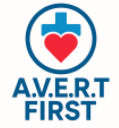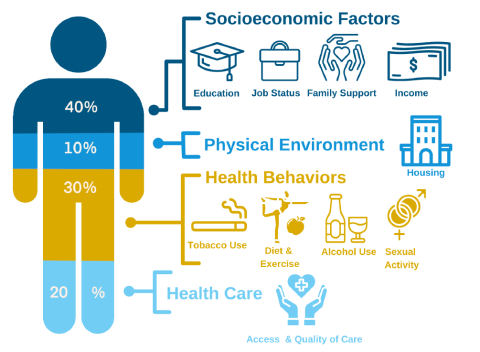
- Transportation, food insecurity, employment services
- Navigation, case management, and community health worker integration
- SDOH screening and referral platforms and infrastructure building
Social Determinants of Health (SDOH) in the Context of A.V.E.R.T. Harm
Introduction
Social Determinants of Health (SDOH) are the conditions in which people are born, grow, live, work, and age. They encompass factors like economic stability, education, social and community context, neighborhood environment, and access to healthcare. SDOH have a profound impact on health outcomes, risk of harm, and the effectiveness of interventions.
A.V.E.R.T. Harm emphasizes that SDOH are not just abstract statistics—they are actionable areas where providers, responders, peers, and communities can intervene to reduce risk, prevent harm, and promote resilience.
1. Core Domains of SDOH
-
Economic Stability
-
Income, employment, food security, housing stability.
-
Impact: Poverty and food insecurity increase susceptibility to chronic disease, mental health stressors, and exposure to harm.
-
A.V.E.R.T. Harm Role: Frontline responders and providers can identify economic vulnerabilities and connect individuals to community resources and financial support programs.
-
-
Education Access and Quality
-
Literacy, early childhood education, vocational training, higher education.
-
Impact: Education influences health literacy, access to information, and long-term economic opportunities.
-
A.V.E.R.T. Harm Role: Providers can screen for low health literacy, provide clear education on harm prevention, and support access to educational programs.
-
-
Healthcare Access and Quality
-
Availability, affordability, cultural competence, and continuity of care.
-
Impact: Limited access increases risks of unmanaged chronic disease, untreated mental health conditions, and delayed interventions.
-
A.V.E.R.T. Harm Role: Clinicians and responders proactively identify barriers and facilitate access, referrals, and advocacy for necessary care.
-
-
Neighborhood and Built Environment
-
Safe housing, clean air and water, transportation, green spaces.
-
Impact: Unsafe or resource-poor environments increase risk for injury, chronic disease, and social harm.
-
A.V.E.R.T. Harm Role: Community responders and public health leaders advocate for safe environments and identify local hazards contributing to harm.
-
-
Social and Community Context
-
Social integration, peer and family support, discrimination, community engagement.
-
Impact: Isolation, discrimination, and lack of support networks increase vulnerability to behavioral health issues, abuse, and social harm.
-
A.V.E.R.T. Harm Role: Peer networks and community programs help buffer risk, provide support, and build resilience.
-
2. The Role of Providers and Responders
SDOH are in our hands because every interaction with a client, patient, or community member is an opportunity to recognize and address these determinants.
Key Actions:
-
Assessment: Screen for social, economic, and environmental risk factors in clinical, social, and community settings.
-
Referral: Connect individuals to appropriate social services, community programs, or financial assistance.
-
Advocacy: Address systemic inequities, advocate for policies that reduce barriers, and promote equity in access to resources.
-
Education: Empower individuals with knowledge about resources, rights, and harm-reduction strategies.
-
Monitoring & Follow-Up: Track outcomes and ensure interventions are effective, adjusting support as needed.
3. Integration with A.V.E.R.T. Harm
-
Structured Awareness: Tools like S.C.A.N.™ help providers and responders systematically identify SDOH-related risks.
-
Early Detection of Harm: Understanding SDOH allows frontline workers and peers to recognize emerging patterns before harm escalates.
-
Cumulative Risk Mitigation: Providers can see how economic, social, and environmental factors combine to increase vulnerability and intervene holistically.
-
Escalation & Systems Connection: When risks exceed immediate support, A.V.E.R.T. Harm protocols guide escalation to clinical, social, or public health systems.
4. Skills and Competencies
-
Cultural competence and humility to understand diverse backgrounds and systemic barriers.
-
Ability to assess social needs alongside clinical or behavioral risks.
-
Knowledge of local resources, community programs, and advocacy pathways.
-
Communication and peer engagement skills to educate and support individuals.
-
Collaborative skills for coordinating with interdisciplinary teams to address systemic determinants.
5. Challenges
-
Social needs may be complex, interrelated, and dynamic.
-
Limited resources or fragmented services can impede effective interventions.
-
Stigma, mistrust, or fear may prevent individuals from disclosing social risk factors.
-
Systemic inequities may require policy-level solutions beyond immediate provider control.
A.V.E.R.T. Harm addresses these challenges by providing structured tools, training for recognition of hidden harms, and protocols for escalation and systemic intervention.
6. Best Practices
-
Use trauma-informed approaches when assessing SDOH.
-
Collaborate across clinical, social, community, and public health systems.
-
Engage peers and community leaders to identify and address barriers.
-
Maintain clear documentation and follow-up to ensure continuity of support.
-
Advocate for policy and environmental changes that improve population-level determinants of health.
7. Conclusion
Social Determinants of Health are fundamental drivers of risk, vulnerability, and resilience. Within the A.V.E.R.T. Harm framework, recognizing and addressing SDOH is literally in the hands of providers, responders, and peers. By assessing, intervening, educating, and advocating, those on the frontlines can reduce harm, strengthen communities, and create pathways for healthier, safer lives.
If you want, I can now produce a complete, integrated A.V.E.R.T. Harm content guide that merges Community & Frontline Support, Clinical & Social Services, Public Health & Systems Leadership, Chronic Disease Management, and SDOH, making it fully comprehensive for training, manuals, or workshops.






